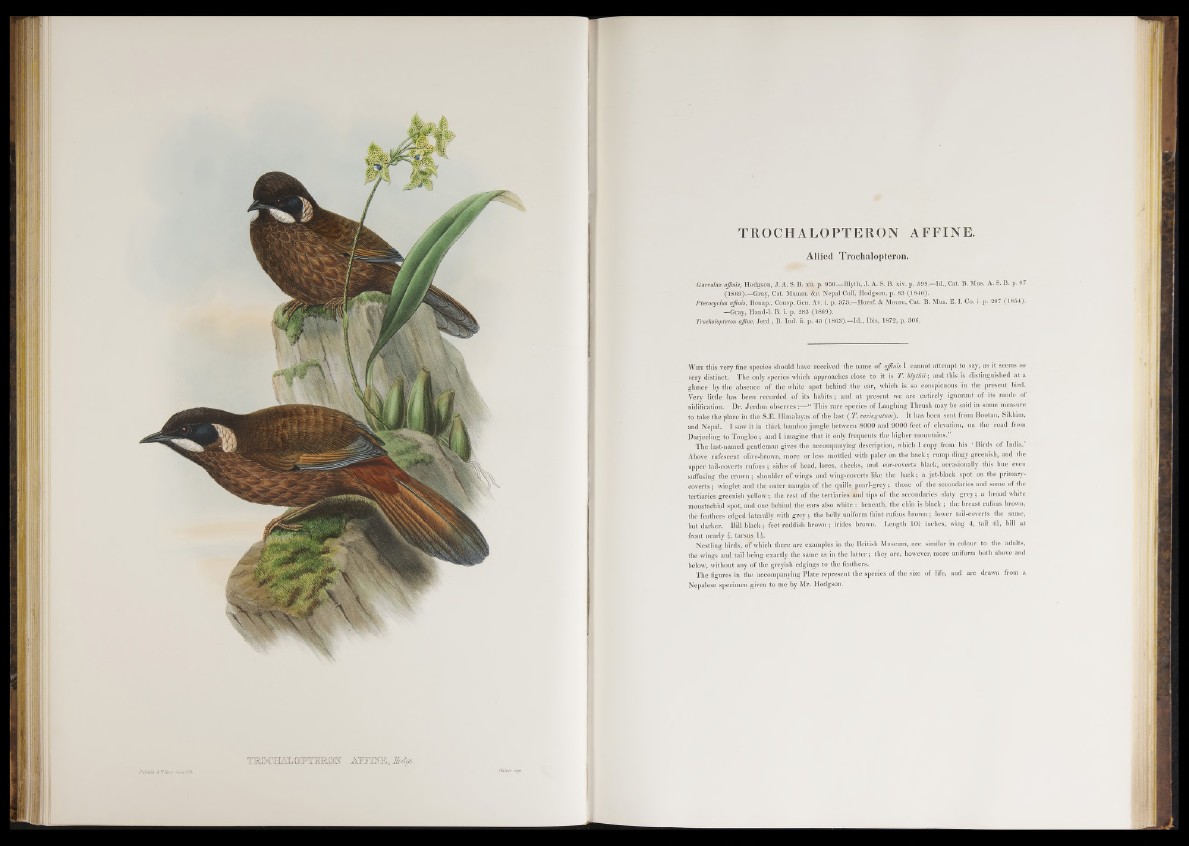
TROCBLàtOlPTERg®
TROCHALOPTERON AFFINE.
Allied Trochalopteron.
Garrulax aj/mis, Hodgson, J .A .S .l i. 950...:Biyth, J. A-. S. B. xiv. p. 599.—Id., Oat. B. Mus. A. S. B. p. 97
(1869).—Gray, Cat. Mamm. & g. Nepal Coll. Hodgson, p. 83 (1846).
Pterocyclm affi/nis, Bonap., Consp. Gen. Av. i. p. 373.—Horsf. & Moore, Cat. B. Mus. E. I. Co. i. p. 20/ (1854).
—Gray, Hand-1. B. i. p. 283 (1869).
Trochalopteron affine, J erd, B. Ind. ii. p. 45 (1863).—Id., Ibis, 1872, p. 306.
Why this very fine species should have received the name of ajjinis I cannot attempt to say, as it seems so
very distinct. The only species which approaches close to it is T . blxjtlin ; and this is distinguished at a
glance by the absence of the white spot behind the ear, which is so conspicuous in the present bird.
Very little has been recorded of its habits ; and at present we are entirely ignorant of its mode of
nidification. Dr. Jerdon observes :—" This rare species of Laughing Thrush may be said in some measure
to take the place in the S.E. Himalayas of the last ( T . variegaturn). I t has been sent from Bootan, Sikhim,
and Nepal. I saw it in thick bamboo jungle between 8000 and 9000 feet of elevation, on the road from
Daijeeling to Tongloo ; and I imagine that it only frequents the higher mountains.”
The last-named gentleman gives' the accompanying description, which I copy from his ‘ Birds of India.
Above rufescent olive-brown, more or less mottled with paler on the back ; rump dingy greenish, and the
upper tail-coverts rufous ; sides of head, lores, cheeks, and ear-coverts black, occasionally this hue even
suffusing the crown ; shoulder of wings and wing-coverts like the back ; a jet-black spot on the primary-
coverts ; winglet and the outer margin of the quillsupearl-grey ; those of the secondaries and some of the
tertiaries greenish yellow ; the rest of the tertiaries ând tips of the secondaries slaty grey ; a broad white
moustachial spot, and one behind the ears also white : beneath, the chin is black ; the breast rufous brown,
the feathers edged laterally with grey ; the belly uniform faint rufous brown ; lower tail-coverts the same,
but darker. Bill black ; feet reddish brown ; irides brown. Length 10è inches, wing 4, tail 4£, bill at
front nearly $, tarsus l i .
Nestling birds, of which there are examples in the British Museum, are similar in colour to the adults,
the wings and tail being exactly the same as in the latter; they are, however, more uniform both above and
below, without any of the greyish edgings to the feathers.
The figures in the accompanying Plate represent the species of the size of life, and are drawn from a
Nepalese specimen given to me by Mr. Hodgson.